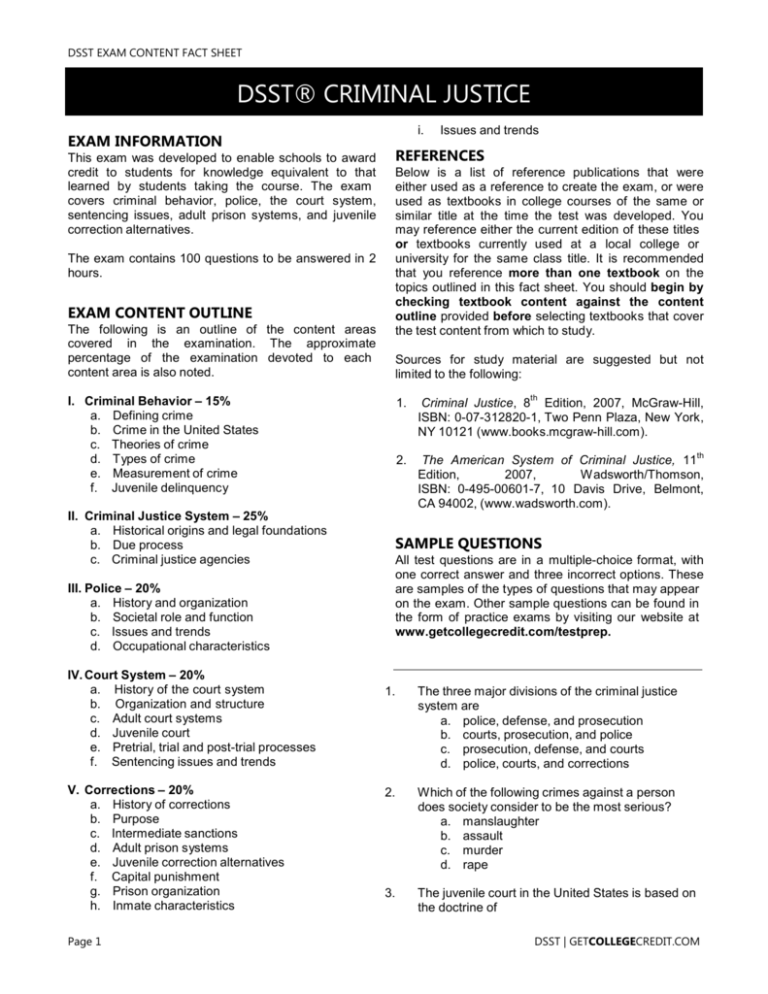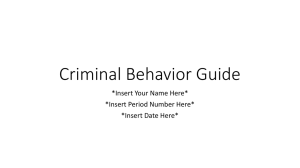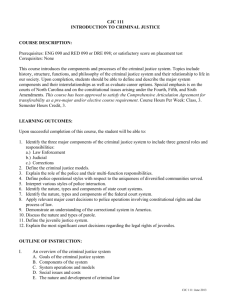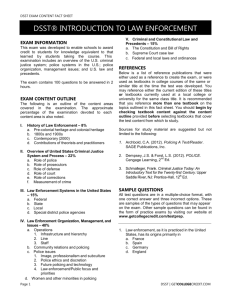DSST® CRIMINAL JUSTICE
advertisement

DSST EXAM CONTENT FACT SHEET DSST® CRIMINAL JUSTICE EXAM INFORMATION This exam was developed to enable schools to award credit to students for knowledge equivalent to that learned by students taking the course. The exam covers criminal behavior, police, the court system, sentencing issues, adult prison systems, and juvenile correction alternatives. The exam contains 100 questions to be answered in 2 hours. EXAM CONTENT OUTLINE The following is an outline of the content areas covered in the examination. The approximate percentage of the examination devoted to each content area is also noted. i. REFERENCES Below is a list of reference publications that were either used as a reference to create the exam, or were used as textbooks in college courses of the same or similar title at the time the test was developed. You may reference either the current edition of these titles or textbooks currently used at a local college or university for the same class title. It is recommended that you reference more than one textbook on the topics outlined in this fact sheet. You should begin by checking textbook content against the content outline provided before selecting textbooks that cover the test content from which to study. Sources for study material are suggested but not limited to the following: I. Criminal Behavior – 15% a. Defining crime b. Crime in the United States c. Theories of crime d. Types of crime e. Measurement of crime f. Juvenile delinquency II. Criminal Justice System – 25% a. Historical origins and legal foundations b. Due process c. Criminal justice agencies III. Police – 20% a. History and organization b. Societal role and function c. Issues and trends d. Occupational characteristics IV. Court System – 20% a. History of the court system b. Organization and structure c. Adult court systems d. Juvenile court e. Pretrial, trial and post-trial processes f. Sentencing issues and trends V. Corrections – 20% a. History of corrections b. Purpose c. Intermediate sanctions d. Adult prison systems e. Juvenile correction alternatives f. Capital punishment g. Prison organization h. Inmate characteristics Page 1 Issues and trends th 1. Criminal Justice, 8 Edition, 2007, McGraw-Hill, ISBN: 0-07-312820-1, Two Penn Plaza, New York, NY 10121 (www.books.mcgraw-hill.com). 2. The American System of Criminal Justice, 11 Edition, 2007, Wadsworth/Thomson, ISBN: 0-495-00601-7, 10 Davis Drive, Belmont, CA 94002, (www.wadsworth.com). th SAMPLE QUESTIONS All test questions are in a multiple-choice format, with one correct answer and three incorrect options. These are samples of the types of questions that may appear on the exam. Other sample questions can be found in the form of practice exams by visiting our website at www.getcollegecredit.com/testprep. 1. The three major divisions of the criminal justice system are a. police, defense, and prosecution b. courts, prosecution, and police c. prosecution, defense, and courts d. police, courts, and corrections 2. Which of the following crimes against a person does society consider to be the most serious? a. manslaughter b. assault c. murder d. rape 3. The juvenile court in the United States is based on the doctrine of DSST | GETCOLLEGECREDIT.COM DSST EXAM CONTENT FACT SHEET – CRIMINAL JUSTICE a. b. c. d. 4. 5. habeas corpus parens patriae nolo contendere modus operandi In the United States, which of the following types of correctional institutions typically has the poorest physical facilities and services? a. county jail b. halfway house c. state prison d. federal prison All of the following are characteristics of criminal acts EXCEPT a. criminal intent b. insanity c. harm to a person d. criminal capacity CREDIT RECOMMENDATIONS The American Council on Education’s College Credit Recommendation Service (ACE CREDIT) has evaluated the DSST test development process and content of this exam. It has made the following recommendations: Area or Course Equivalent Level Criminal Justice Amount of Credit Minimum Score Six (6) semester hours Source American Council on Education – College Credit Recommendation Service Lower-level baccalaureate 400 Answers to sample questions: 1-D; 2-C; 3-B; 4-A; 5-B. Rev 3/14 Page 2 DSST | GETCOLLEGECREDIT.COM









